Introduction
East Indian hygrophila, also known as Miramar weed, Indian swampweed, and hygro, is an invasive aquatic plant that grows under submersed and emergent conditions. The species' center of origin is unclear, but it is thought to be native to the East Indies, India, Malaysia, and Taiwan (UF/IFAS CAIP 2015). Although many species of Hygrophila are found throughout the world, only the introduced species H. polysperma and H. corymbosa as well as the native H. costata are found in Florida. East Indian hygrophila is classified by the USDA as an obligate wetland plant, meaning it almost always occurs in flooded or wetland habitats as opposed to more terrestrial environments (USDA NRCS 2015). The species is a federally listed noxious weed (USDA NRCS 2015) and a Florida Class II prohibited aquatic plant (FDACS DPI 2015). Class II Prohibited Aquatic Plants may be grown by registered nurseries but shipped only to customers outside of Florida. However, East Indian hygrophila's status as a federal noxious weed means that nurseries must also obtain a federal permit for interstate movement and a state permit for culture of the species. Accordingly, the UF/IFAS Assessment of Non-Native Plants in Florida's Natural Areas lists East Indian hygrophila as a prohibited plant (UF/IFAS Assessment 2016).
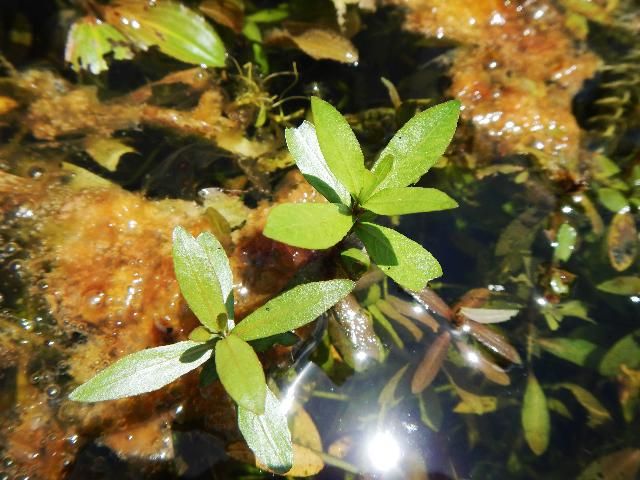
Credit: Lyn Gettys, UF/IFAS
East Indian hygrophila was first introduced to the United States as an aquarium plant around 1945. It was cultivated by an aquarium dealer in Ohio at the end of WWII and was originally called "oriental ludwigia" (UF/IFAS CAIP 2015). The first recorded sighting of East Indian hygrophila in Florida occurred near Tampa in 1965, but the species was misidentified until 1977 (Les and Wunderlin 1981). By 1980, East Indian hygrophila had become a weed problem in south Florida canals, and by 1994, it had spread to 18 of Florida's public bodies of water (UF/IFAS CAIP 2015).
Classification
Common Names: East Indian hygrophila, hygrophila, Miramar weed, Indian swampweed, hygro
Scientific Name: Hygrophila polysperma (Roxb.) T. Anderson
Family: Acanthaceae (waterwillow family) (USDA NRCS 2015)
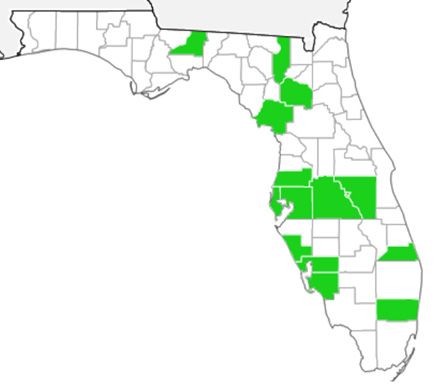
Credit: EDDMapS. 2015. Early Detection & Distribution Mapping System. The University of Georgia - Center for Invasive Species and Ecosystem Health. Available online at https://www.eddmaps.org; last accessed March 7, 2015.
Description and Habitat
East Indian hygrophila is established in freshwater systems in more than a dozen counties in Florida. It is likely present but unreported more widely throughout the state. Populations also occur in Texas, Alabama, South Carolina, Kentucky, and Virginia (EDDMapS 2015).
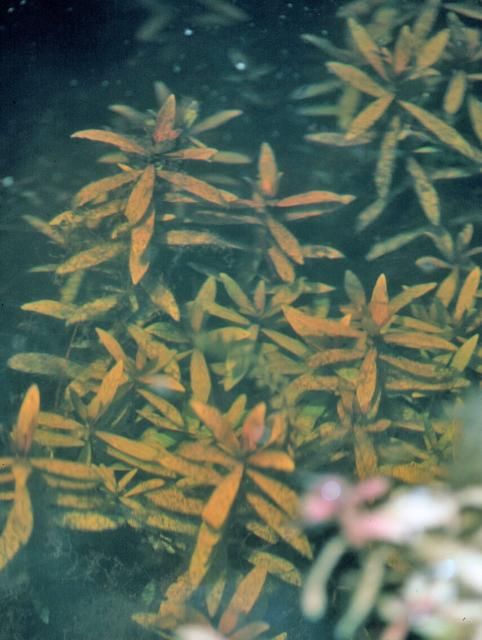
Credit: David Sutton, UF/IFAS
The species is most commonly found growing under submersed conditions with the uppermost part of the plant emerging above the water, but plants can also grow along shorelines and other areas with wet soil. It prefers to grow in areas of moving water such as streams and canals, but it also grows in still waters where little flow occurs.
East Indian hygrophila has square stems and leaves that are attached in pairs opposite one another along the stems. The species forms dense, low-growing, and creeping mats along shorelines and in other emergent conditions. Stems can grow up to 10 feet long under submersed conditions. Submersed leaves are lanceolate (sword-shaped) to elliptic, up to 2 inches long, thin, and attached to the stem by a short petiole (leaf stalk). In contrast, leaves on emergent growth are usually shorter, thick, fleshy, and sessile (attached directly to the stem without a petiole). Leaf color in both forms varies, ranging from green to brown, bronze, and red. Emergent leaves and stems are often covered with dense hairs, but submersed growth is usually smooth and hairless (Sutton 1996).
Flowers of East Indian hygrophila are produced only on the emergent growth that occurs along shorelines and on "topped-out" submersed populations with aerial stems. Flowers are small (up to 0.375 inches across), blue to white, and attached directly to upper parts of the stems in the leaf axils. The flowers have two "lips" or petal-like structures, and the lower lip has three lobes. East Indian hygrophila flowers from October to March in Florida. Plants produce copious amounts of tiny seeds in a narrow capsule that is up to 0.75 inches long. The importance of seed production for establishment and spread of this species is unknown (Sutton 1995).
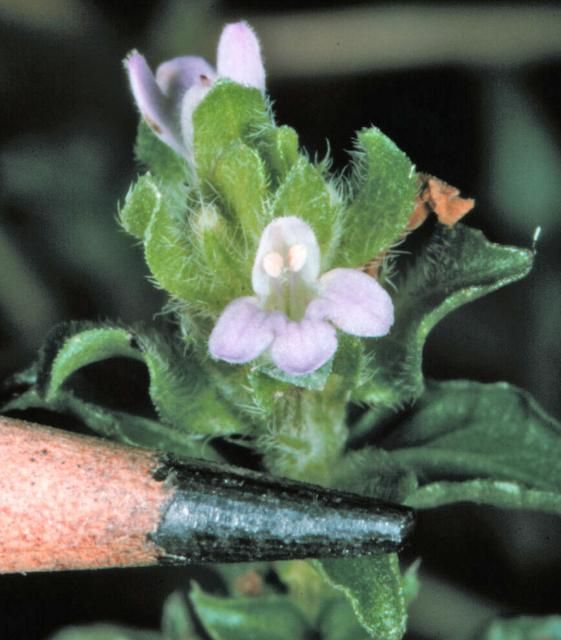
Credit: David Sutton, UF/IFAS
Small fragments and sections of leaves will readily produce roots and form new plants (Peters 2001). It is likely that the plant's spread and colonization of new areas occur mostly through vegetative means because the stems of East Indian hygrophila are somewhat fragile and easily break into fragments.

Credit: David Sutton, UF/IFAS
Similar to other submersed weeds, dense populations of East Indian hygrophila can cause a number of significant problems in aquatic ecosystems. Submersed weeds such as East Indian hygrophila may go unnoticed until they form surface mats. By this point, plants have been growing unchecked, sometimes for months, and the water column has been filled with plant material. East Indian hygrophila and other submersed weeds also grow very quickly. For example, an infestation of East Indian hygrophila on Lake Tohopekaliga in central Florida expanded from 0.1 acres in 1979 to at least 10 acres in 1980 (Vandiver 1980). As a result, these species frequently outcompete native aquatic plants and form dense monocultures (populations of a single species) that are poor habitats for aquatic fauna, most of which require a diverse environment in order to thrive. Dense plant growth can also trap heat. This raises the temperature of surface water and depletes dissolved oxygen in the shaded lower portion of the water column, resulting in conditions that negatively impact fish. Robust populations of East Indian hygrophila can obstruct water flow in flood-control canals, which can have serious consequences if resource managers need to quickly move large volumes of water to prevent flooding during tropical storms, hurricanes, and other severe weather events. Large mats of fragments may also collect at culverts and interfere with water control pump stations. Recreational uses of infested waters are limited as well. For example, boat motors quickly become clogged with weeds, and fishing lines can snag shortly after being cast.
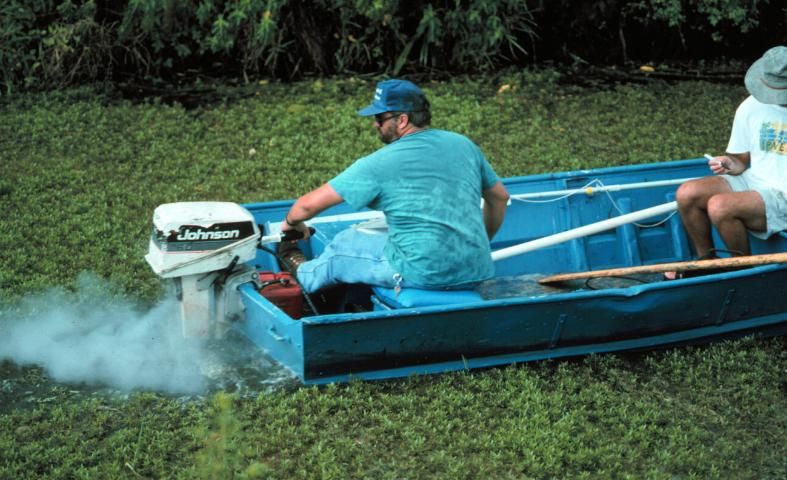
Credit: David Sutton, UF/IFAS
Control
Sources quoted by Vandiver in 1980 indicated that East Indian hygrophila was a popular aquarium plant and had been found at a number of geographically separated sites throughout Florida, including Miramar and Margate (Broward County), Conservation Area 3 and the Palm Beach County Canal (Palm Beach County), the Hillsborough and Alafia Rivers near Tampa (Hillsborough County), East Lake Tohopekaliga near Orlando (Osceola County), and ponds and canals in Lee County. It is probable that East Indian hygrophila made its way into Florida's waters as a result of multiple aquarium dumps around the state. This type of intentional introduction has been implicated in the establishment and spread of other aquatic weeds as well, including the relatively new invader rotala (Rotala rotundifolia) (Gettys and Della Torre 2014). Clearly, the most effective way to avoid the problems associated with East Indian hygrophila and other invasive plants is exclusion, or preventing them from entering uninfested aquatic systems. Unfortunately, a surprising number of aquarium owners remain unaware of the ecological consequences associated with the release of introduced species into public waters. Although intentional release was most likely the vector for initial introductions of East Indian hygrophila, accidental transfer of this and other submersed species frequently occurs when boats, trailers, and other equipment are moved from an invaded site to an uninfested one. Therefore, anything that has been used in waters where East Indian hygrophila is present should be carefully inspected before being moved to another aquatic system. Any plant fragments must be removed to prevent the introduction of this noxious weed to uninfested bodies of water (Gettys et al. 2013).
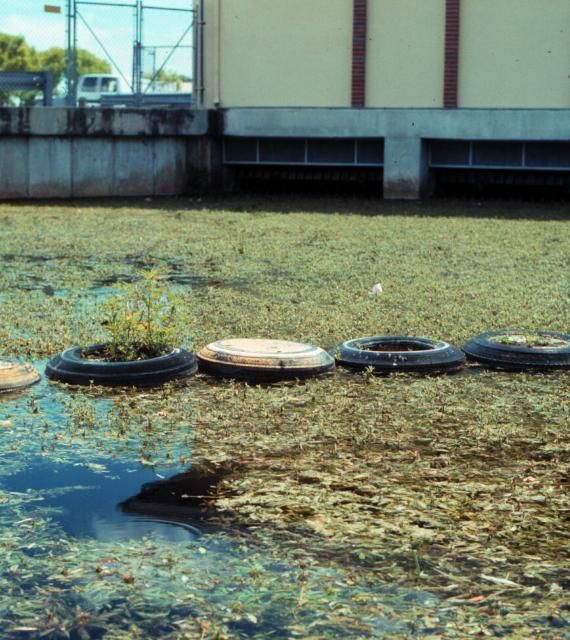
Credit: David Sutton, UF/IFAS
Once East Indian hygrophila has been discovered in an aquatic system, swift action must be taken to control the weed and reduce or prevent its impacts. Although hand pulling and mechanical removal are useful techniques for the management of certain aquatic weeds, these methods create a significant number of fragments that may actually spread infestations of East Indian hygrophila. Therefore, these methods are not recommended. Certain aquatic weeds can be managed using biological control agents that are either host-specific (only attacking a single species) or generalist (attacking many species). There are no biological control agents that only attack East Indian hygrophila. In addition, the generalist triploid grass carp (Ctenopharyngodon idella) devours a wide variety of aquatic plants, but does not consume or cause measurable damage to East Indian hygrophila. Therefore, the primary means of management for this noxious weed is chemical control through the use of herbicides.
Previous reports stated that East Indian hygrophila was tolerant of most herbicides labeled for aquatic use and that this species was more difficult to control than hydrilla (Hydrilla verticillata), which is Florida's most intensively managed submersed weed (Hall and Vandiver 1990). For example, products containing the active ingredient endothall have limited activity on East Indian hygrophila and are used mostly for suppression. However, the protox inhibitor flumioxazin reportedly provides good control of East Indian hygrophila at 200 to 400 ppb (Valent 2012). Flumioxazin is very sensitive to water pH and breaks down quickly when pH is greater than 8.5, so it should be applied early in the morning (or even before dawn if possible) in high-pH waters to lessen the likelihood of reduced efficacy. If the diluent (tank/mix water) has a pH equal to or greater than 7, it may be useful to add a buffering agent to decrease the tank solution to a pH of 5 to 7. Also, because flumioxazin is a contact herbicide, retreatment of infested waters is often recommended to ensure that any plant material surviving initial treatment is controlled by a subsequent application. The auxin mimic florpyrauxifen-benzyl (labeled for aquatic use as ProcellaCOR SC in 2018) also provides good control of East Indian hygrophila. Greenhouse trials conducted in Davie, FL revealed that biomass of East Indian hygrophila was reduced by 90% when submersed plants were exposed to 5 or 10 ppb of florpyrauxifen-benzyl for at least three days or when they were exposed to 20 ppb for at least one day (Gettys et al. 2021).
Summary
East Indian hygrophila is a submersed aquatic weed that has invaded a number of aquatic systems in the southeastern United States. The species was initially cultivated in Florida as an aquarium plant and was likely introduced to Florida's waters through multiple aquarium dumps. East Indian hygrophila is a federally listed noxious weed and a Florida Class II prohibited plant, meaning cultivation, sale, and possession of this species without state and federal permits are prohibited in Florida. Established populations of East Indian hygrophila interfere with human uses of bodies of water and disrupt ecosystems by forming dense, impenetrable monocultures that clog the water column, restrict water flow, and create poor habitat for aquatic fauna. There are few options for management of East Indian hygrophila because techniques that cause fragmentation can actually spread the species. However, the herbicides flumioxazin and florpyrauxifen-benzyl appear to provide acceptable control of this noxious weed when used according to label directions.
References
FDACS DPI. 2015. "Florida Department of Agriculture and Consumer Services Division of Plant Industry Prohibited Aquatic Plants." Florida Administrative Code & Florida Administrative Register. Accessed on July 6, 2015. https://www.flrules.org/gateway/RuleNo.asp?title=AQUATIC%20PLANT%20IMPORTATION,%20TRANSPORTATION,%20NON-NURSERY%20CULTIVATION,%20POSSESSION%20AND%20COLLECTION&ID=5B-64.011
Gettys, L. A. and C. J. Della Torre III. 2014. Rotala: A New Aquatic Invader in Southern Florida. SS-AGR-376. Gainesville: University of Florida Institute of Food and Agricultural Sciences. https://edis.ifas.ufl.edu/publication/ag381
Gettys, L. A., W. T. Haller, and G. E. MacDonald. 2013. "Chapter 13: Herbicides in aquatic systems." Pages 329–351 in: Price, A. [ed.] Herbicides—Current Research and Case Studies in Use. https://doi.org/10.5772/56015
Gettys, L. A., K. L. Thayer, M. A. Heilman, and E. M. Van Goethem. 2021. “Effect of florpyrauxifen-benzyl concentration–exposure time on hygrophila and rotala.” Journal of Aquatic Plant Management 59: 79–84.
Hall, D. W., and V. V. Vandiver, Jr. 1990. Weeds in Florida. Publication SP 37. Gainesville: University of Florida Institute of Food and Agricultural Sciences. 43 pp.
Les, D. H., and R .P. Wunderlin. 1981. "Hygrophila polysperma (Acanthaceae)." Florida Scientist 44: 189–92.
Peters, S. 2001. "Plant propagation via leaf cuttings in four aquatic species: Bur-marigold, sky flower, East Indian hygrophila and water primrose." University of Florida Journal of Undergraduate Research 2(8): 1–7. Accessed on September 8, 2022. https://ufdc.ufl.edu/UF00091523/00088
Sutton, D. L. 1995. "Hygrophila is replacing hydrilla in south Florida." Aquatics 17: 4–10.
Sutton, D. L. 1996. "Life cycle and phenology of hygrophila in relation to development of management strategies." Pages 51–68 in: Stocker, R. K. [ed.]. Control Technologies for Use against the Submersed Aquatic Weeds Hydrilla and Hygrophila. USDA-ARS No. 58-6629-4-008. Center for Aquatic Plants, University of Florida, Gainesville, Florida.
UF/IFAS Assessment. 2016. UF/IFAS Assessment of Non-Native Plants in Florida's Natural Areas. Accessed on September 23, 2016. https://assessment.ifas.ufl.edu
UF IFAS CAIP. 2015. "East Indian hygrophila: Hygrophila polysperma." Accessed on September 8, 2022. https://plants.ifas.ufl.edu/plant-directory/hygrophila-polysperma/
USDA NRCS. 2015. "Hygrophila polysperma (Roxb.) T. Anderson: Indian swampweed." Accessed on October 19, 2015. https://plants.usda.gov/home/plantProfile?symbol=HYPO3
Valent. 2012. Clipper Herbicide Label. Accessed on July 19, 2015. http://www.valent.com/Data/Labels/2012-CLP-0001%20Clipper%20-%20form%201791-B.pdf
Vandiver, V. V. Jr. 1980. "Hygrophila." Aquatics 2: 4–11.